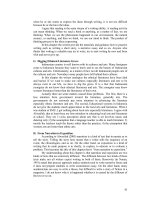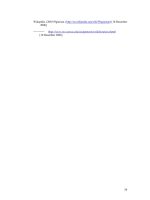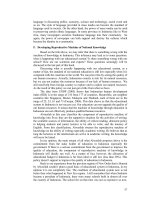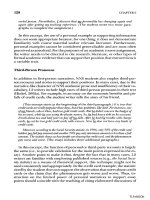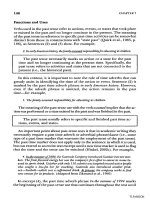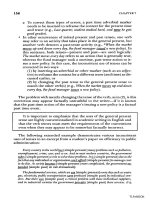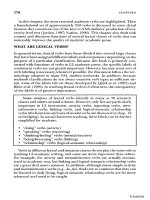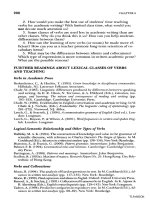Tài liệu Teaching and learning english part 14 doc
Bạn đang xem bản rút gọn của tài liệu. Xem và tải ngay bản đầy đủ của tài liệu tại đây (405.38 KB, 7 trang )
92
ENCOURAGING QUESTIONING IN ENGLISH READING
COMPREHENSION FOR THE SECOND YEAR STUDENTS OF MAN MODEL
MANADO
Sri Suharti
I. INTRODUCTION
Reading is an activity with purpose. It is an interactive process that goes on
between the reader and the text, resulting in comprehension. The purpose of reading is
to connect the ideas on the page to what we already know. The purpose of reading also
determines the appropriate approach to reading comprehension. Moreover, teaching
reading will not be successfully if the students can only reads words, without
understanding the message being read. In other words, what ever we read, it should be
understood. Smith and Robinson (1980) argue that “Comprehension means
understanding”. This means that reading comprehension is a process of thought where
the readers understand the writer’s ideas and interpret them into his or her own needs.
And it is generally accepted that the major goal for any reading activity is
comprehension. Comprehension is the essence of reading. The writer creates a text to
communicate a message; the reader’s task is to comprehend that message (Anderson et
all ; 1969 ; Robinson 1975 ; Harmer 1983 ; Suhor 1988). This goal is in line with the
objective of teaching reading in high school. However, the changing of national
curriculum doesn’t describe that it will also change the teachers’ views on how to
improve the teaching style of English in general, specifically in reading. It seems that
the teaching of reading mostly doesn’t give opportunities to students to involve in the
activities since the teachers usually only ask the students to translate and do text based
questions. In other words, students are rarely trained to arouse interest and curiosity
concerning to the topic which is being read. Whereas the curiosity of the students to the
topic discussed can be aroused in simple ways, it is questioning.
Questioning is a critical strategy that helps readers make meaning of literature
by promoting critical thinking about what is being read
( />). Questioning
occurs as a natural part of the classroom routine as teachers encourage students to pose,
discuss, and answer questions. Questions can be generated by the reader, a peer, the
teacher, or curriculum developers. Any one of these kinds of questions can be answered
by the student individually, after discussion with others, or in collaboration with peer.
“Almost everywhere children are schooled to become at answering questions and to
remain novices at asking” (Dillon cited by Van Der Meij, 1993). Why is that so? Do
students and lack the necessary skills? Do schools not stimulate questioning enough?
The answer is probably that both skills and conditions are important.
Reece, Ian and Walker, Stephen argues “Communication is a two way process,
where you want to communicate to your students and you want your students to
communicate with you. Question and answer is a good way to develop this interaction
style of communication”. Moreover, to be successful, independent learners need to be
able to ask interesting questions. Wonder gives birth to creativity. Based on the
quotation above, it can be concluded that question and answer is important to do in
communication although it is stimulated through reading texts.
93
Interest and motivation are expressed through questions. New knowledge is built
by means of questioning. Yet most students in most traditional content classrooms ask
very few lesson-related questions. In teachers’ perception, this fact is caused by the
students lack interest and motivation. For the most part, however, lack of interest and
motivation is only a secondary symptom. The primary cause of apathy, in most cases, is
that students simply do not know how to ask questions in the classroom environment,
which can be layered with subtle inhibitions, to questioning. Seeing the low ability of
students in questioning, a good teacher should create strategies which can courage
students to arise questions by learning from various texts in reading activities. Derived
from the text given, it is hoped students can be stimulated to ask questions individually,
in pairs, groups, even to do questions and answers with teachers. The teaching of
learning process will become learners-centered. It is in line with the concept of
comprehension that students will be courage to search out importations from text by
formulating questions by themselves and then become discussion. Regarding to the
problems above, the writer wants to conduct a research entitled “Encouraging
Questioning in Reading Activities for the second year students of MAN Model
Manado” to better the students’ ability in reading. It is assumed that this strategy can
develop students’ reading ability, especially their comprehension.
RESEARCH QUESTIONS
1. Is questioning strategy effective in teaching reading comprehension?
2. What are students’ attitudes towards the application of questioning strategy?
II. DISCUSSION
In doing her research, she can apply the three approaches, what so called”
Empiricist approach, Interpretive approach and Critical approach”.
EMPIRICIST APPROACH
First, to see the effectiveness of applying Questioning in teaching reading, the
researcher will do a research with quasi experimental design. She will choose two
classes to be samples randomly. One class for experimental group and the other one is
as a control group. Before giving the treatment to the experimental group, the researcher
will give pre-test first for those two groups to get the data of their ability in reading.
Then the experimental group will be given a treatment by applying Questioning strategy
in teaching reading, while the control group does not. At the end of the research, those
two groups will be given post-test to see whether there is significant difference
achievement in their reading between the experiment and control group. The data
gathered will be evaluated using the T-test formula. If it is found that the experiment
group’s result is higher than the control group’s, it can be concluded that the
questioning strategy is effective in teaching reading skill. This theory is in line with the
concept in the Empiric approach. Knowledge is objective, generalisable and can be used
to predict and control future event.
INTERPRETIVE APPROACH
To get more detail data whether the improvement is caused by the questioning
strategy, the researcher can do also a case study. It is done to validate the data gathered
because there might be some factors influence the conditions. In line with the theory in
Interpretive approach that the emphasis is on understanding by the researcher and the
researched rather than prediction and control, she wants to do observation on how the
94
students respond questions in reading activities or which questions they ask and what
are students’ attitudes towards questioning? Tape recordings of the question-answer
interactions also will be done to complete the observation. In doing the observation, the
researcher will ask college to do observation also to have crosscheck finding. Thing that
will be observed covers all activities done by the students and teacher, also what is said
by students and teacher in teaching learning process. To support the data gathered from
observation, the interviews of the teacher and pupil will be done to get the data on how
is students’ attitudes toward the application of questioning strategy in English reading
activities and it will be recorded. Individual interview as well as focus group interview
will be conducted to gain validation data collection. Moreover all the data gained will
be described and transcribed to answer the research questions and to derive conclusion
whether the condition of students’ ability in having questioning activities in reading is
better or worse. Since “the data concerned appear in words rather than in numbers”
(Miles and Huberman, 1984), it is in term of qualitative research.
CRITICAL APPROACH
The critical approach also can be done by the researcher to find the power
relationship between teacher and students to do questioning in reading activities. First,
she tries to find some factors that influence why students stop asking questions since it
can be caused by teachers sometimes respond to questions with sarcastic replies. In
additional, as teachers, we occasionally use questions as a kind of “weapon” against
student misbehavior, etc. The fact can be considered as obstacles for students to get
involvement in learning and they tend to stop asking questions. Even, this condition can
be caused by habituation done by the teachers that in reading activities, mostly students
only assign to do text-based questions. Teachers never encourage them to arouse their
own questions based on what information the students want to search out etc. she will
conduct classroom action research which involves the expert to get feedback and input
in applying questioning strategy in teaching reading. The cycle actions in improving the
application of questioning strategy will always be done to get improvement on students’
achievement in reading comprehension by finding the agreement between the researcher
and the expert. So in this case, the concept of collaborative research will be employed to
better the condition.
III. CONCLUSION
Since the purpose of conducting the research is to find the data whether the
application of questioning is appropriate to develop students’ reading ability, so the
finding can be followed up by the other researcher to find the more appropriate strategy
for students in reading activities. If the finding can prove that questioning strategy is
effective to improve students’ comprehension, it is suggested for English teachers in
senior high school to apply also this strategy rather than using text based questions only.
References:
Anderson, J. Durston B. H., and Poole M.E.1969. Efficient Reading: A Practical Guide.
Sydney: McGraw-Hill Book Company.
Smith, Bob. et. all. 1990. Issues and Methods in Research : Study Guide. South
Australia: South Australian College of Advanced Education.
95
Smith and Robinson. 1980. Efficient Reading, A partial Guide to Reading
Comprehension Sciences, New York; Cambridge University Press.
Van Der Meij, Hans. 1993. A Case Study of Questioning in Reading.
/>.
96
Analyzing Total Educational Program
Muhammad Syukrianto
A. Introduction
It has long been recognized that education is viewed a primary means for
solving social problems. Education provides people with the tools and knowledge
they need to understand and participate in their daily life. It also helps to sustain the
human values that contribute to individual and collective well-being. Therefore,
realizing the important of education, from time to time the quality of education
should be improved.
Most experts in education believe that one of the ways to improve the
quality of education is through curriculum development. As a matter of fact, the
curriculum is the core of education, since it provides rigorous planning and program
to reach the objectives of education. Sailor, (1981) defines the Curriculum as a plan
for providing sets of learning opportunities for person to be educated. From this
definition, it can be concluded that the core of educational improvement is in the
well programmed of curriculum.
In this short paper, actually, we are going to discuss the total educational
program. In writer’s perspective, the total educational program refers to the well
programmed of curriculum. Discussing educational programs, we may have
different perspective since in each level of educations we can find the process of
programming. The governments have their own programs in education, nationally
and provincially. At school, we are also familiar with school program. In classroom,
a teacher has programs to implement in his or her teaching and learning process.
From these different perspectives, hence, the well programmed of curriculum that
we are going to discuss refers to and focus on the discussion of curriculum content.
B. A Perspective
Concerning with the program in curriculum development, I would like to
make an analog of a curriculum with a computer. In a computer development, the
core of computer is in
the program. Someone who develops the program is called a
programmer. The process of a computer development is started from a situational
analysis, to decide the need and the situation on that time. And then, the developers
company formulated the goals and objective to decide what types of computer to
develop. After that, they develop programs (computer programs) as the core of a
computer. The programs are then installed and implemented by the users.
The core of curriculum, in this case, is in the program which is called
curriculum content. Curriculum is developed started from a situational analysis, goal
formulation and then program building or content building. To understand the
process and interrelation between curriculum and program, it can be figured with the
following skillbeck model (Print, 1993).
C. Program Building (Curriculum Content)
This appears to be a natural phenomenon that the process of curriculum
programming includes a wide range of activities. Print, (1998: 140) states the
starting point for constructing a curriculum lies with the program building or the

